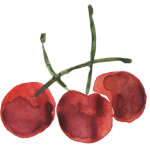Award Winning Author
Face Reading with Before & After Photos
Cherry Bounce
It’s cherry season, and because these rubies are not great shippers or keepers, now’s the time to indulge. Here’s an easy recipe that transforms the essence of cherries into a tasty liqueur that is also a medicin al tonic.
al tonic.
Historians note that in September 1784 George Washington packed a canteen of cherry bounce for a trip west across the Allegheny Mountains. It was not, however, recorded whether he imbibed for its perky flavor or as a tonic. Either way, as its name suggests, this fruit liqueur imbues you with bounce, and it is a kitchen remedy to counter carpal tunnel, arthritis and gout. This link has more on the medicinal properties of cherries.
While you may bounce either sweet or sour cherries, favor sour cherries, as they contain more anti-inflammatory, antioxidant and pain-relieving properties than sweet cherries. Sour cherries are so meltingly tender and perishable that they bruise at a touch and are thus difficult to find fresh. Not to worry—you may use frozen cherries with equal success.
Note: Commercial cherries are one of the fruits highest in pesticide residues; favor organic cherries.
Cherry Bounce
Makes approximately 2 quarts liqueur and 1 quart cherries
6 cups fresh or unsweetened frozen and thawed sour or sweet cherries
1 or 2 cups unrefined cane sugar
4 tablespoons fresh lemon juice, if using sweet cherries
2 teaspoons whole allspice or cloves, optional
2 cinnamon sticks, optional
1 quart brandy, rum, whiskey or vodka
If you are using fresh cherries, remove and discard the cherry stems, but do not pit them. Wash and dry the fruit and pack it (or, if using thawed frozen fruit, just pack it) into 2 quart-size glass jars. Add 1 cup of sugar to each jar if you are using sour cherries. If you are using sweet cherries, add ½ cup sugar to each jar, along with 2 tablespoons lemon juice per jar. Add the spices, if using. Cover with brandy.
Stir, cover, tightly, and set on the counter. Over the next few days, stir a few times, or invert the jar until the sugar dissolves several times a day. After 4 days, place it in a cool cellar or refrigerate it for 6 to 8 weeks.
Strain, bring the bounce to room temperature, and serve in small cordial or wine glasses, as you would serve a liqueur. It will keep refrigerated for a year or more. While most of the cherry essence is now in the liqueur, you may pit the cherries and enjoy them as a fortified, all-natural version of the maraschino.


Last summer I steeped the elderberries in vodka, but did not add sugar. I loved the fragrance and took a few spoons during Thanksgiving week when I had a cough. Today, Dec. 16, I strained them. Two cups of elderberries produced scant 3/4 cup liquid. Into that I added one tsp. sugar and I am supposed to wait another month or so.
I poured a simple syrup over the berries and will try that over ice cream with a touch of allspice or black pepper.
Thanks to Niki for her advice. I had read that parts of the bush are poisonous including the tiny stems. Removing them was a slow meditative process, a nice job for a hot summer’s day.
My bush is Sambucus Nigra. I read that the poisons in stems, leaves and unripe berries are cyanogenic glycoside and alkaloids. I did taste a few raw berries. They were not that yummy but I did not get stomach upset or any of the other symptoms associated with thoses poisons.
At summer’s sunrise the bush was full of birds feasting on the berries. I loved sharing the bush with them and a type of moth caterpillar that wove gorgeous webs (fall webworm). Nice memories on this December day.
Diane, Thanks so much for this additional information.I have such fond memories of elderberry harvests and of my uncle making elderberry whistles from the stems. Have you ever turned the blossoms into a lacy fritter? Just dip them into a crepe batter and cook.
It is my understanding that while cooked Elderberries are safe and delicious Raw Elderberries are poisonous. I would be most concerned about anyone making Elderberry Bounce with uncooked berries. 🙂
http://www.yummly.com/blog/2011/07/6-poisonous-plants-people-love-to-eat/
As fermenting is a kind of cooking, not to worry. There’s a long–and healthful–history of fermenting elderberries into wine. Yes raw elderberries can be a mild toxin if eaten in quantity. But saying they’re poisonous is perhaps overboard?
Can’t wait to try this!
Elderberries are here. I wonder if the recipe can be used to preserve them for winter?
Give it a try and let me know.